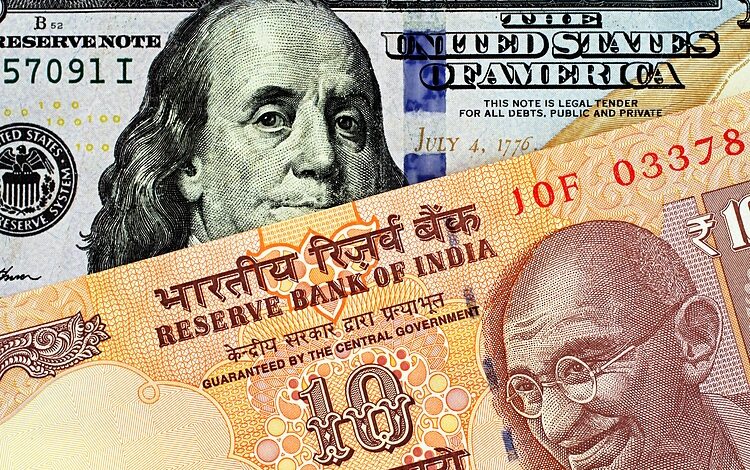USD/INR trades softer ahead of US CPI, Fed rate decision

- Indian Rupee edges higher on Wednesday amid the firmer US Dollar.
- The potential FX intervention from the RBI might protect INR from further weakness.
- The Indian Consumer Price Index (CPI) for May is due on Wednesday ahead of the US key events.
Indian Rupee (INR) trades on a positive note on Wednesday despite the stronger US Dollar (USD). The downside for the INR might be limited as the Reserve Bank of India (RBI) is likely to prevent local currency from depreciating. On the other hand, the weakness in Asian peers, the rise in crude oil prices, and the cautious mood might drag the INR lower.
India’s May Consumer Price Index (CPI) and Industrial Production are due on Wednesday. On the US front, the CPI inflation data will be released ahead of the Federal Reserve (Fed) monetary policy meeting. The Fed is widely expected to maintain policy rates steady at its June meeting on Wednesday. Investors will closely monitor Fed Chair Jerome Powell’s message during the press conference for more clues about any modifications to the interest rate dot plot. The hawkish tone from the Fed’s Powell could boost the US Dollar and create a tailwind for the pair.
Daily Digest Market Movers: Indian Rupee gains traction ahead of the key events from both India and the US
- The one-month implied volatility of the USD/INR pair has dropped to 2.20%, down from a six-month peak of 3.35% in May.
- “Don’t think there’s a lot of fresh positioning (on USD/INR) currently as people are mostly waiting for Fed and US (inflation) data,” said a foreign exchange trader at a private bank.
- India’s CPI inflation is expected to rise to 4.90 YoY in May from 4.83% in April.
- World Bank stated in its June Global Economic Prospects report that India will remain the fastest-growing of the world’s largest economies with a steady average annual growth of 6.7% between FY25 and FY27.
- The US headline CPI figure is estimated to show an increase of 3.4% YoY in May, while the core CPI for May is projected to rise 3.5% YoY.
- Interest rate futures are pricing in about 38 basis points (bps) of rate cuts over 2024, down from nearly 50 bps last week.
Technical analysis: USD/INR’s positive outlook persists in the longer term
The Indian Rupee trades stronger on the day. The positive outlook of the USD/INR pair prevails as the pair is above the key 100-day Exponential Moving Average (EMA) and descending trend channel upper boundary.
Further consolidation cannot be ruled out in the near term, supported by the neutral 14-day Relative Strength Index (RSI), which stands flat around the 50-midline.
The next upside barrier will emerge at 83.72, a high of April 17. Further north, the next hurdle to watch is the 84.00 psychological mark. On the flip side, the crucial support level is seen at 83.30, portraying the confluence of the 100-day EMA and descending trend channel upper boundary. A breach of this level will pave the way to 82.78, a low of January 15.
US Dollar price this week
The table below shows the percentage change of US Dollar (USD) against listed major currencies this week. US Dollar was the weakest against the New Zealand Dollar.
| USD | EUR | GBP | CAD | AUD | JPY | NZD | CHF | |
| USD | 0.34% | -0.12% | -0.08% | -0.53% | 0.23% | -0.65% | 0.17% | |
| EUR | -0.34% | -0.47% | -0.42% | -0.86% | -0.12% | -0.99% | -0.18% | |
| GBP | 0.11% | 0.46% | 0.05% | -0.40% | 0.35% | -0.53% | 0.30% | |
| CAD | 0.08% | 0.42% | -0.05% | -0.44% | 0.32% | -0.57% | 0.24% | |
| AUD | 0.55% | 0.89% | 0.42% | 0.44% | 0.73% | -0.13% | 0.69% | |
| JPY | -0.22% | 0.14% | -0.34% | -0.30% | -0.73% | -0.87% | -0.07% | |
| NZD | 0.64% | 0.96% | 0.50% | 0.56% | 0.12% | 0.87% | 0.80% | |
| CHF | -0.17% | 0.18% | -0.29% | -0.24% | -0.69% | 0.06% | -0.81% |
The heat map shows percentage changes of major currencies against each other. The base currency is picked from the left column, while the quote currency is picked from the top row. For example, if you pick the Euro from the left column and move along the horizontal line to the Japanese Yen, the percentage change displayed in the box will represent EUR (base)/JPY (quote).
Indian economy FAQs
The Indian economy has averaged a growth rate of 6.13% between 2006 and 2023, which makes it one of the fastest growing in the world. India’s high growth has attracted a lot of foreign investment. This includes Foreign Direct Investment (FDI) into physical projects and Foreign Indirect Investment (FII) by foreign funds into Indian financial markets. The greater the level of investment, the higher the demand for the Rupee (INR). Fluctuations in Dollar-demand from Indian importers also impact INR.
India has to import a great deal of its Oil and gasoline so the price of Oil can have a direct impact on the Rupee. Oil is mostly traded in US Dollars (USD) on international markets so if the price of Oil rises, aggregate demand for USD increases and Indian importers have to sell more Rupees to meet that demand, which is depreciative for the Rupee.
Inflation has a complex effect on the Rupee. Ultimately it indicates an increase in money supply which reduces the Rupee’s overall value. Yet if it rises above the Reserve Bank of India’s (RBI) 4% target, the RBI will raise interest rates to bring it down by reducing credit. Higher interest rates, especially real rates (the difference between interest rates and inflation) strengthen the Rupee. They make India a more profitable place for international investors to park their money. A fall in inflation can be supportive of the Rupee. At the same time lower interest rates can have a depreciatory effect on the Rupee.
India has run a trade deficit for most of its recent history, indicating its imports outweigh its exports. Since the majority of international trade takes place in US Dollars, there are times – due to seasonal demand or order glut – where the high volume of imports leads to significant US Dollar- demand. During these periods the Rupee can weaken as it is heavily sold to meet the demand for Dollars. When markets experience increased volatility, the demand for US Dollars can also shoot up with a similarly negative effect on the Rupee.
Information on these pages contains forward-looking statements that involve risks and uncertainties. Markets and instruments profiled on this page are for informational purposes only and should not in any way come across as a recommendation to buy or sell in these assets. You should do your own thorough research before making any investment decisions. FXStreet does not in any way guarantee that this information is free from mistakes, errors, or material misstatements. It also does not guarantee that this information is of a timely nature. Investing in Open Markets involves a great deal of risk, including the loss of all or a portion of your investment, as well as emotional distress. All risks, losses and costs associated with investing, including total loss of principal, are your responsibility. The views and opinions expressed in this article are those of the authors and do not necessarily reflect the official policy or position of FXStreet nor its advertisers. The author will not be held responsible for information that is found at the end of links posted on this page.
If not otherwise explicitly mentioned in the body of the article, at the time of writing, the author has no position in any stock mentioned in this article and no business relationship with any company mentioned. The author has not received compensation for writing this article, other than from FXStreet.
FXStreet and the author do not provide personalized recommendations. The author makes no representations as to the accuracy, completeness, or suitability of this information. FXStreet and the author will not be liable for any errors, omissions or any losses, injuries or damages arising from this information and its display or use. Errors and omissions excepted.
The author and FXStreet are not registered investment advisors and nothing in this article is intended to be investment advice.




